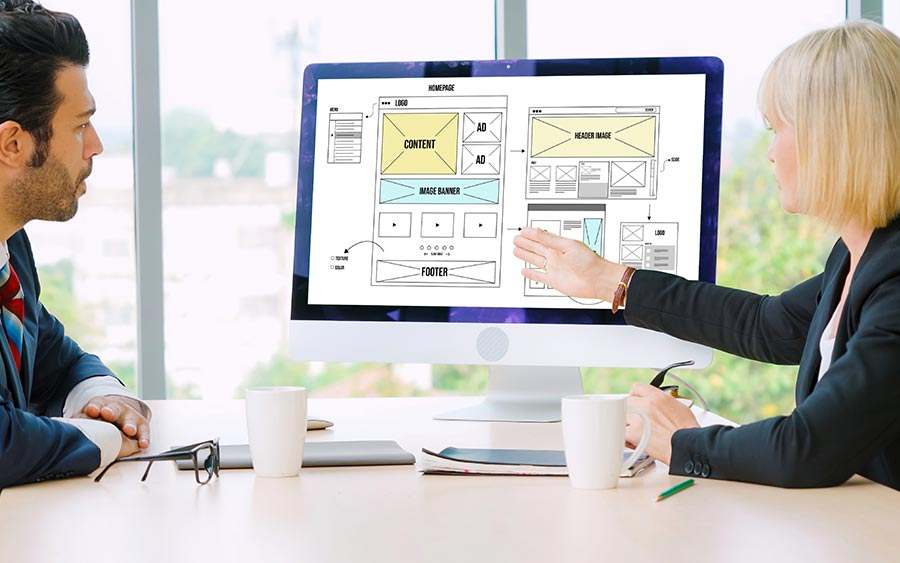Welcome to the exciting world of web design! As a website owner or designer, you know that creating an engaging and user-friendly interface is essential for attracting and retaining visitors. But have you ever encountered those frustrating moments when your perfectly crafted design seems to cause friction for your users? Don’t worry, you’re not alone! In this blog post, we will explore the concept of web design friction, its different types, common causes, and most importantly – how to solve it. So buckle up and get ready to smooth out those rough edges in your website’s user experience!

What is web design friction? It’s the pesky little roadblocks that hinder a smooth and seamless user experience on a website. It’s those moments when users feel frustrated, confused, or even annoyed by certain aspects of your site. Think of it as the metaphorical speed bumps in the digital world.
There are different types of web design friction, each with its own set of challenges. One common type is cognitive friction, which occurs when users have difficulty understanding or navigating through your site’s content. Another type is visual friction, where elements like cluttered layouts or poor color choices make it hard for users to focus on what really matters.
Now, you might be wondering if web design friction is always a bad thing. Well, not necessarily! While too much friction can drive users away from your site, a little bit can actually be beneficial. For instance, strategically placing some obstacles in the form of forms or opt-ins can help qualify leads and enhance user engagement.
However, excessive friction will undoubtedly harm your website’s performance and ultimately affect conversions and customer satisfaction levels. So finding the right balance between usability and conversion optimization is crucial.
But what causes web design friction in the first place? Several factors contribute to this phenomenon: unclear navigation menus that leave visitors feeling lost; slow-loading pages that test their patience; complex checkout processes that discourage them from completing purchases; inconsistent branding that confuses them about where they are on your site – just to name a few!
Fortunately, there are ways to solve these issues and minimize web design friction. Conducting thorough user research helps identify pain points so you can address them effectively. Streamlining navigation menus simplifies browsing for visitors while optimizing page load times keep their attention intact.
Improving overall usability through intuitive interfaces ensures an effortless user experience while implementing clear calls-to-action guides them towards desired actions without any confusion. Consistency across all touchpoints reinforces brand recognition and trustworthiness.
Web design friction is the enemy of a smooth user experience. Understanding its various types and how to solve them is key to creating a successful website. So let’s get to work!
When it comes to web design, friction can manifest in various ways. Understanding the different types of web design friction is crucial for creating a smooth and user-friendly experience. Let’s dive into some common types of web design friction that users may encounter.
1. Navigation Friction:
One type of web design friction occurs when users struggle to navigate through a website. Confusing menus, hidden links, or overly complex navigation structures can all contribute to this problem.
2. Form Friction:
Forms are an essential part of many websites, but if they’re not designed well, they can create frustration for users. Long or confusing forms with unnecessary fields or unclear instructions can lead to abandonment.
3. Loading Time Friction:
Slow-loading websites are a major source of frustration for users today. Waiting too long for pages or images to load can lead visitors to bounce from your site and seek alternatives elsewhere.
4. Content Overload Friction:
Sometimes less is more when it comes to content on a webpage. Having too much information crammed onto one page without clear organization and hierarchy creates visual clutter and makes it difficult for users to find what they need.
5. Mobile Responsiveness Friction:
In today’s mobile-driven world, having a website that isn’t optimized for mobile devices is a surefire way to frustrate users who expect seamless experiences across all devices.
By understanding these different types of web design friction, you’ll be better equipped to identify potential issues in your own designs and take steps toward improving the overall user experience.
Web design friction, like any other aspect of web design, has its own set of pros and cons. On one hand, it can provide a unique and engaging user experience by making the website more interactive and memorable. By incorporating friction into the design elements such as buttons or navigation menus, users are forced to pay closer attention to their actions, reducing the chances of accidental clicks.
Additionally, it can also help guide users through complex processes or decision-making tasks by breaking them down into smaller steps. This can increase user engagement and satisfaction as they feel supported throughout their journey on the website.
However, it’s important to note that excessive use of it can have its drawbacks. Too much friction can lead to frustration and abandonment among users who prefer a seamless browsing experience. It may also deter potential customers from completing desired actions such as making a purchase or filling out a form.
Finding the right balance between usability and engagement is crucial when implementing web design friction. It requires careful consideration of your target audience’s preferences and behaviors to ensure that you’re enhancing their experience rather than hindering it with unnecessary obstacles.
By understanding both the advantages and disadvantages associated with it, you can make informed decisions about how best to incorporate it into your website while keeping your audience’s needs in mind
1. Complex Navigation: One of the most common causes of web design friction is complex navigation. When users can’t easily find the information they’re looking for, frustration sets in. Cluttered menus, unclear labels, and a lack of intuitive organization can all contribute to this issue.
2. Slow Loading Speed: In today’s fast-paced digital world, people have little patience for slow-loading websites. If your site takes too long to load, visitors are likely to abandon it and never return. Factors such as large image files, excessive use of plugins or scripts, and poor hosting can all contribute to sluggish loading speeds.
3. Lack of Mobile Optimization: With mobile internet usage surpassing desktop usage, it’s crucial to ensure that your website is optimized for mobile devices. Failing to do so can result in a frustrating user experience with elements overlapping or being difficult to tap on small screens.
4. Poor Readability: Websites with tiny font sizes or low contrast between text and background make it difficult for users to read the content comfortably. This leads to eye strain and frustration.
5. Complicated Forms: Lengthy forms requiring excessive personal information or confusing validation processes are major culprits when it comes to web design friction.
By addressing these common causes of web design friction through thoughtful layout planning, simplified navigation structures, responsive design techniques, optimizing page speed performance, and enhancing readability factors like font size and color contrast ratios; businesses can create enjoyable user experiences that keep visitors engaged on their websites for longer durations.
When it comes to solving web design friction, there are several strategies that can be employed. One common cause of friction is slow loading times, which can frustrate users and lead them to abandon a website. To address this issue, optimizing images and code, as well as utilizing caching techniques, can help improve page load speeds.
Another common challenge is poor navigation or confusing layout. Users should be able to easily find what they’re looking for without having to dig through multiple pages or menus. Simplifying the navigation structure and ensuring clear labels and intuitive design choices can go a long way in reducing friction.
Responsive design is also crucial in today’s mobile-first world. Websites must adapt seamlessly across different devices and screen sizes. By implementing responsive design principles and testing on various devices, you can ensure a smooth experience for all users.
Additionally, addressing usability issues such as form errors or broken links is essential in minimizing friction. Conducting thorough testing before launching a website will help identify any potential issues that may hinder user interaction.
Regularly gathering feedback from users through surveys or analytics tools can provide valuable insights into areas of improvement. Listening to your audience’s feedback and making necessary adjustments based on their needs will ultimately reduce friction and enhance the overall user experience.
By implementing these strategies, web designers can effectively solve web design friction and create websites that are user-friendly and engaging.
In this blog post, we delved into the concept of web design friction and explored its various types, as well as the pros and cons associated with it. We also discussed the common causes that lead to web design friction and provided some effective solutions to overcome these challenges.
Web design friction can significantly impact a website’s user experience and hinder its overall performance. It can discourage visitors from exploring further, leading to high bounce rates and low conversion rates. However, when utilized strategically, certain types of web design friction can be beneficial in guiding users toward desired actions.
Understanding the different forms of it is crucial for designers and developers in order to create websites that are both visually appealing and user-friendly. By addressing common causes such as slow loading speed, complex navigation systems, cluttered layouts, or confusing forms, we can enhance usability and eliminate unnecessary barriers for users.
To solve it effectively, it is important to conduct thorough research on target audiences’ preferences and behaviors. This will enable you to make informed decisions about layout structure, visual elements placement, content organization, and other aspects that contribute to a seamless user experience. Regular testing through A/B testing or usability testing also proves valuable in identifying potential issues early on.
Remember that each website has unique requirements based on its purpose and target audience. Therefore optimizing your site’s performance by reducing web design friction requires continuous evaluation of metrics like bounce rate or time-on-page along with feedback from users through surveys or comments sections.
By prioritizing user-centric designs coupled with thoughtful attention given to eliminating unnecessary obstacles while maintaining an engaging experience for visitors – you’ll be able to build websites that not only attract but also retain satisfied users who keep coming back for more!
So go ahead! Embrace the challenge of minimizing web design friction today because ultimately your efforts will pay off by offering an enhanced browsing journey for all those who visit your website!

Why Hiring an SEO Professional in Roseville CA Can Transform Your Business

How to Find the Best WordPress Expert in Roseville for Your Website

How Local SEO Services in Sacramento Can Boost Your Business’s Online Presence

Why You Need the Best Web Designers in Sacramento for Your Business

Enhance Your Online Presence with Custom Web Design in Roseville CA

Top Strategies in Digital Marketing for Chiropractors

5 Reasons Why You Should Hire a Roseville WordPress Web Designer for Your Business Website